(P.S.) I realize I am merely an amateur and I have a lot of getting better to do and I want to do so. So I would truly appreciate any kind of criticism. Please don't hold back. And of course, ask me anything you would like to know.
Can Cebeci's Gallery
Forum rules
READ: The Origami Forum Rules & Regulations
READ: The Origami Forum Rules & Regulations
-
Can Cebeci
- Junior Member
- Posts: 55
- Joined: September 8th, 2014, 9:26 pm
Can Cebeci's Gallery
Hi! I want to introduce myself first. I am a Turkish student born in '99. I have been folding origami models for a few years and I enjoy doing so. I recently graduated from high school (yay!). Naturally, I spent most of my time studying to get into a good college this past year so I couldn't fold anything. Now that I am past that stage I want to pick up where I left off and I want to share my work with you. I am not really good at designing yet so most of my stuff will be designs from authors that I admire. I hope you like them as much as I do and I wish my gallery somehow inspires somebody 
(P.S.) I realize I am merely an amateur and I have a lot of getting better to do and I want to do so. So I would truly appreciate any kind of criticism. Please don't hold back. And of course, ask me anything you would like to know.
(P.S.) I realize I am merely an amateur and I have a lot of getting better to do and I want to do so. So I would truly appreciate any kind of criticism. Please don't hold back. And of course, ask me anything you would like to know.
-
Can Cebeci
- Junior Member
- Posts: 55
- Joined: September 8th, 2014, 9:26 pm
Re: Can Cebeci's Gallery
Here is the first one. I hope I figured out uploading images.
Indiana Jones' Fedora by Robert Lang
Paper: 10*10 cm tissue foil
Instructions: The crease pattern is on his website
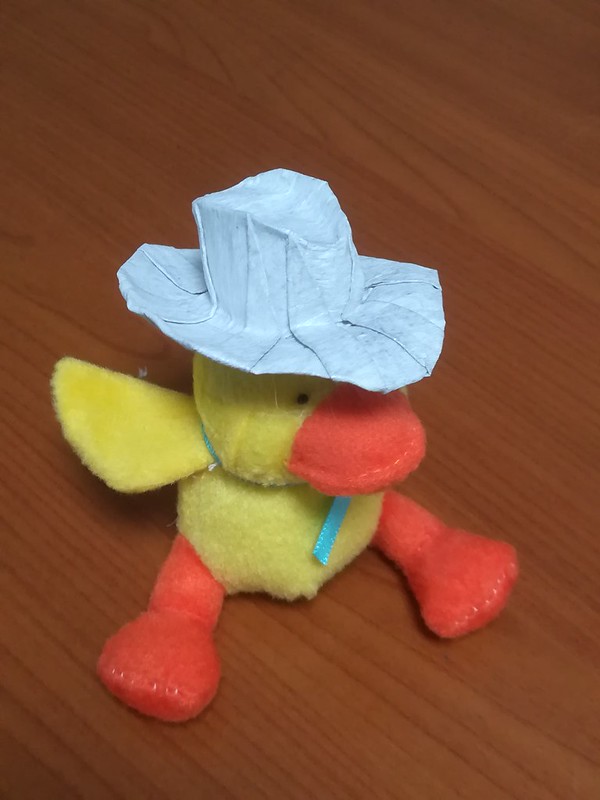 IJ's_fedora1[1] by Can Cebeci, on Flickr
IJ's_fedora1[1] by Can Cebeci, on Flickr
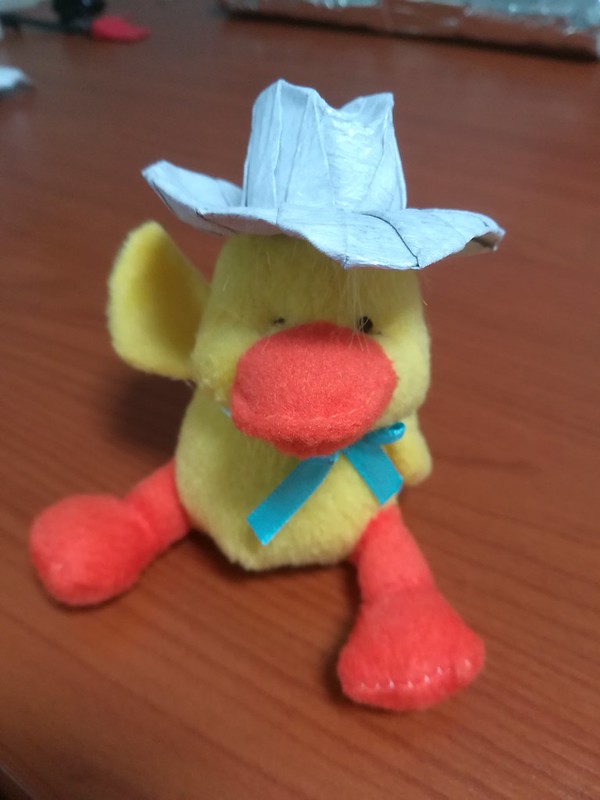 IJ's_fedora2[1] by Can Cebeci, on Flickr
IJ's_fedora2[1] by Can Cebeci, on Flickr
Indiana Jones' Fedora by Robert Lang
Paper: 10*10 cm tissue foil
Instructions: The crease pattern is on his website
 IJ's_fedora1[1] by Can Cebeci, on Flickr
IJ's_fedora1[1] by Can Cebeci, on Flickr IJ's_fedora2[1] by Can Cebeci, on Flickr
IJ's_fedora2[1] by Can Cebeci, on Flickr-
Can Cebeci
- Junior Member
- Posts: 55
- Joined: September 8th, 2014, 9:26 pm
Re: Can Cebeci's Gallery
This model may not be that complex but it is definitely one of my favorite designs. Its simplicity, paper efficiency and cuteness make it great  Hideo Komatsu truly is a genius. Plus, I think it was a great choice to get reacquainted with crease patterns. I recommend it to people asking how to get started with them.
Hideo Komatsu truly is a genius. Plus, I think it was a great choice to get reacquainted with crease patterns. I recommend it to people asking how to get started with them.
Squirrel by Hideo Komatsu
Paper: 13*13 tissue foil
Instructions: The CP is on his web gallery (http://www.origami.gr.jp/~komatsu/gallery/index.html) and for people who want to fold it through diagrams they appear on Works Of Hideo Komatsu and also on Tanteidan #3.
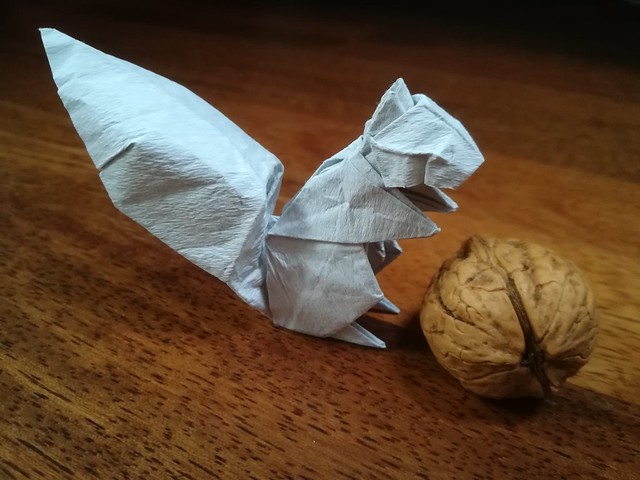 Komatsu_Squirrel by Can Cebeci, on Flickr
Komatsu_Squirrel by Can Cebeci, on Flickr
Squirrel by Hideo Komatsu
Paper: 13*13 tissue foil
Instructions: The CP is on his web gallery (http://www.origami.gr.jp/~komatsu/gallery/index.html) and for people who want to fold it through diagrams they appear on Works Of Hideo Komatsu and also on Tanteidan #3.
 Komatsu_Squirrel by Can Cebeci, on Flickr
Komatsu_Squirrel by Can Cebeci, on Flickr-
Can Cebeci
- Junior Member
- Posts: 55
- Joined: September 8th, 2014, 9:26 pm
Re: Can Cebeci's Gallery
This one of the more advanced models. I love every part of it. I have to admit that it's my third time folding this model with a year in between each one. The first two, I made with Nicolas Terry's tissue foil which I ordered online and they were a lot bigger. Now this one is made with home made tissue foil and it turned out to be the best. The asymmetry, the crumpled beard/face and the round shaping make folding this model quite fun. And I must say the result is pretty satisfying,too. That one sure is not the most complex design of Satoshi Kamiya but I can say without a doubt that it is my favorite. Thank you for publishing it Master Kamiya! 
Wizard by Satoshi Kamiya
Paper: 30*30 tissue foil
Instructions: Diagrams in Works of Satoshi Kamiya
For some reason I photographed the base
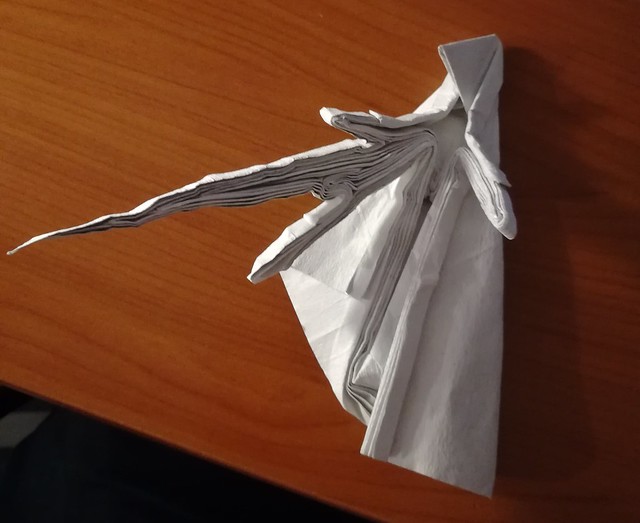 Kamiya_wizard_base by Can Cebeci, on Flickr
Kamiya_wizard_base by Can Cebeci, on Flickr
 Kamiya_wizard_1 by Can Cebeci, on Flickr
Kamiya_wizard_1 by Can Cebeci, on Flickr
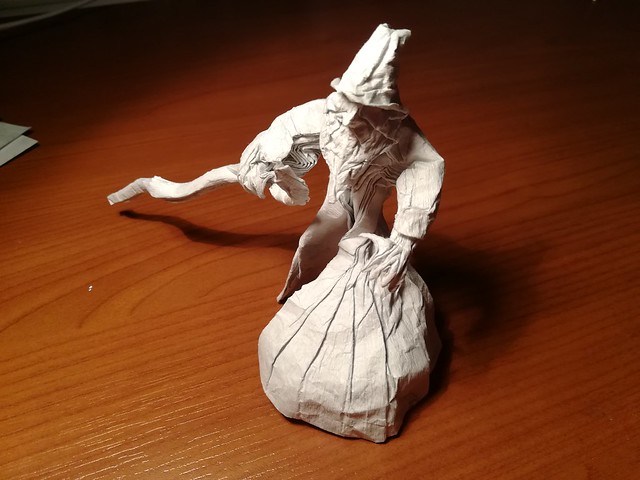 Kamiya_wizard_2 by Can Cebeci, on Flickr
Kamiya_wizard_2 by Can Cebeci, on Flickr
The book in the background is Lord of the Rings since he kind of looks like Gandalf
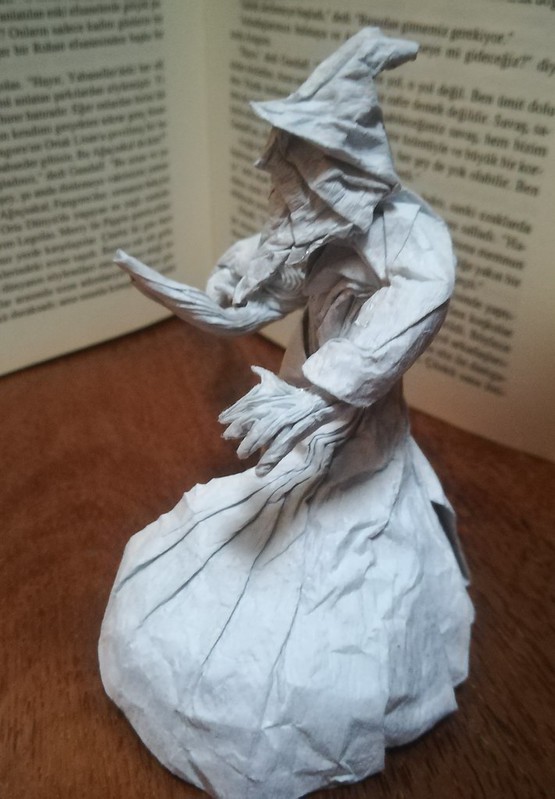 Kamiya_wizard_3 by Can Cebeci, on Flickr
Kamiya_wizard_3 by Can Cebeci, on Flickr
Wizard by Satoshi Kamiya
Paper: 30*30 tissue foil
Instructions: Diagrams in Works of Satoshi Kamiya
For some reason I photographed the base
 Kamiya_wizard_base by Can Cebeci, on Flickr
Kamiya_wizard_base by Can Cebeci, on Flickr Kamiya_wizard_1 by Can Cebeci, on Flickr
Kamiya_wizard_1 by Can Cebeci, on Flickr Kamiya_wizard_2 by Can Cebeci, on Flickr
Kamiya_wizard_2 by Can Cebeci, on FlickrThe book in the background is Lord of the Rings since he kind of looks like Gandalf
 Kamiya_wizard_3 by Can Cebeci, on Flickr
Kamiya_wizard_3 by Can Cebeci, on Flickr-
NeverCeaseToCrease
- Forum Sensei
- Posts: 502
- Joined: April 7th, 2017, 4:54 am
- Location: USA
Re: Can Cebeci's Gallery
Congrats on your graduation!
I would disagree that you are an amateur, because anybody who could fold Satoshi Kamiya's Wizard and the Fedora that neatly is pretty experienced.
If you ever want to design your own models, I would recommend the book Origami Design Secrets by Robert J Lang, preferably the second edition. If you haven't read it already he goes through the process of creating both box pleated and circle packed models, with examples of his own designs to held demonstrate.
Happy Folding!
I would disagree that you are an amateur, because anybody who could fold Satoshi Kamiya's Wizard and the Fedora that neatly is pretty experienced.
If you ever want to design your own models, I would recommend the book Origami Design Secrets by Robert J Lang, preferably the second edition. If you haven't read it already he goes through the process of creating both box pleated and circle packed models, with examples of his own designs to held demonstrate.
Happy Folding!
My instagram: https://www.instagram.com/theplantpsychologist/
My youtube: https://www.youtube.com/channel/UCJPCcy ... U8oLMv5WpQ
My flickr: https://www.flickr.com/people/185437267@N03/
My youtube: https://www.youtube.com/channel/UCJPCcy ... U8oLMv5WpQ
My flickr: https://www.flickr.com/people/185437267@N03/
-
Can Cebeci
- Junior Member
- Posts: 55
- Joined: September 8th, 2014, 9:26 pm
Re: Can Cebeci's Gallery
Thanks  I am truly flattered. About the ODS, I started reading it before the semester started and read like a quarter of it but then I had to give it up. I am definitely going to read it this summer though. It was a great and unique book. Thanks for reminding me.
I am truly flattered. About the ODS, I started reading it before the semester started and read like a quarter of it but then I had to give it up. I am definitely going to read it this summer though. It was a great and unique book. Thanks for reminding me.
Happy folding it is!
Happy folding it is!
Re: Can Cebeci's Gallery
Welcome and congratulations. I particularly liked how Squirrel looked. What paper did you use? How come all your folds are in white? Just being curious  .
.
.
My awesome website: https://www.neorigami.com
and Instagram account: https://instagram.com/NeorigamiCom
My awesome website: https://www.neorigami.com
and Instagram account: https://instagram.com/NeorigamiCom
-
Can Cebeci
- Junior Member
- Posts: 55
- Joined: September 8th, 2014, 9:26 pm
Re: Can Cebeci's Gallery
Thank you  The paper is home made tissue foil. It is made by glueing aluminium foil and tissue paper together. If you haven't tried making it yet, I highly recommend that you do. All of my models are in white because I thought white would make the wizard look like Gandalf and I made my tissue foil in white. The other two models are made of the paper excessed after I cut the square for wizard from the tissue. Do expect more colorful models from me in the near future.
The paper is home made tissue foil. It is made by glueing aluminium foil and tissue paper together. If you haven't tried making it yet, I highly recommend that you do. All of my models are in white because I thought white would make the wizard look like Gandalf and I made my tissue foil in white. The other two models are made of the paper excessed after I cut the square for wizard from the tissue. Do expect more colorful models from me in the near future.
-
Can Cebeci
- Junior Member
- Posts: 55
- Joined: September 8th, 2014, 9:26 pm
Re: Can Cebeci's Gallery
Here is a model I folded before all this studying began. 9 months ago or something. I actually saw this model somewhere when I first got started with origami and I loved it. Then for some reason I forgot about it. It was so satisfying coming across it again and folding a nice Nazgul.
Nazgul 8.1 by Jason Ku
Paper: 30*30 cm tissue foil
Instruction: Diagrams are printed on Tanteidan #129
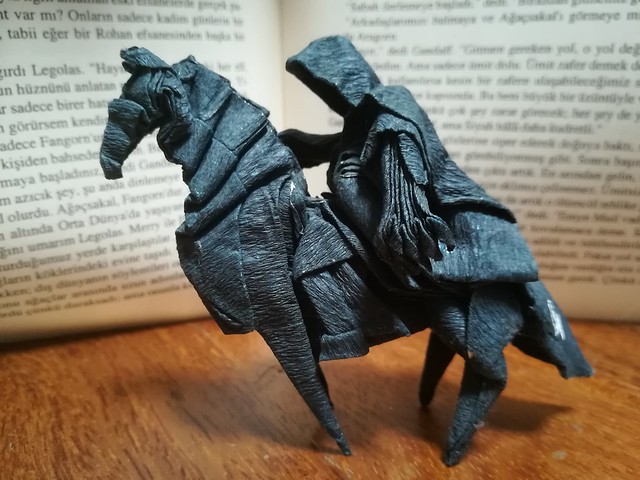 Jason Ku Nazgul 8.1 by Can Cebeci, on Flickr
Jason Ku Nazgul 8.1 by Can Cebeci, on Flickr
The hand looks kind of awkward but I just couldn't take a photo where it was clearly visible. The troubles of black paper I guess.
Nazgul 8.1 by Jason Ku
Paper: 30*30 cm tissue foil
Instruction: Diagrams are printed on Tanteidan #129
 Jason Ku Nazgul 8.1 by Can Cebeci, on Flickr
Jason Ku Nazgul 8.1 by Can Cebeci, on FlickrThe hand looks kind of awkward but I just couldn't take a photo where it was clearly visible. The troubles of black paper I guess.
-
Can Cebeci
- Junior Member
- Posts: 55
- Joined: September 8th, 2014, 9:26 pm
Re: Can Cebeci's Gallery
I came up with a design of my own! It is not perfect but it's something. It is actually the ace of spades playing card. I know the spade looks odd but the way I like to see it is that every deck of playing cards has a unique ace of spades specially designed to fit them and this could be the one for a deck with origami for a theme. Anyway I hope you like it 
Ace of spades by Can Cebeci
Paper: 21*21 tissue foil
Instructions: The CP is right here on this post
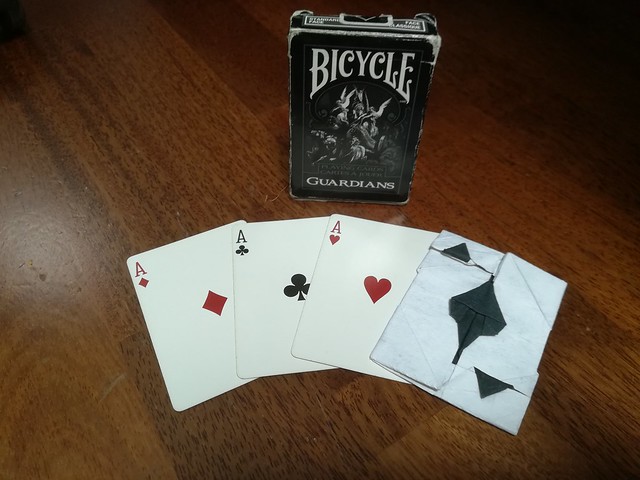 ace_of_spades_1 by Can Cebeci, on Flickr
ace_of_spades_1 by Can Cebeci, on Flickr
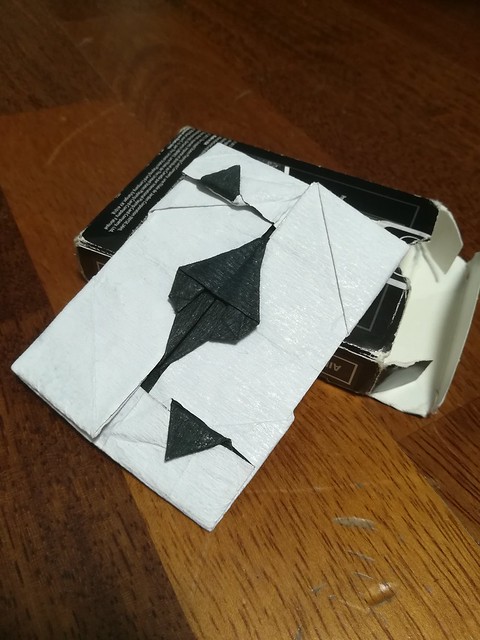 ace_of_spades_2 by Can Cebeci, on Flickr
ace_of_spades_2 by Can Cebeci, on Flickr
The back is quite flat
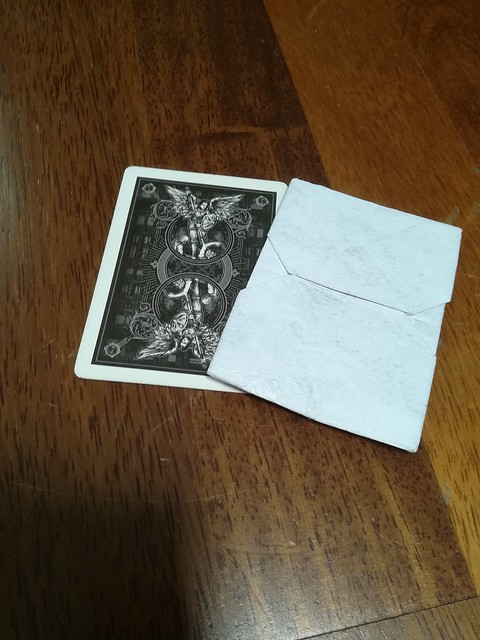 ace_of_spades_3 by Can Cebeci, on Flickr
ace_of_spades_3 by Can Cebeci, on Flickr
And the CP
 ace_of_spades_cp by Can Cebeci, on Flickr
ace_of_spades_cp by Can Cebeci, on Flickr
I did the measurement and the sizes I put on the CP are the way to go if you want to get the correct width for a poker sized playing card. Also I photographed the model while folding it so I might share the photodiagrams for after collapsing the CP. Let me know if you would like to see them.
Ace of spades by Can Cebeci
Paper: 21*21 tissue foil
Instructions: The CP is right here on this post
 ace_of_spades_1 by Can Cebeci, on Flickr
ace_of_spades_1 by Can Cebeci, on Flickr ace_of_spades_2 by Can Cebeci, on Flickr
ace_of_spades_2 by Can Cebeci, on FlickrThe back is quite flat
 ace_of_spades_3 by Can Cebeci, on Flickr
ace_of_spades_3 by Can Cebeci, on FlickrAnd the CP
 ace_of_spades_cp by Can Cebeci, on Flickr
ace_of_spades_cp by Can Cebeci, on FlickrI did the measurement and the sizes I put on the CP are the way to go if you want to get the correct width for a poker sized playing card. Also I photographed the model while folding it so I might share the photodiagrams for after collapsing the CP. Let me know if you would like to see them.
Re: Can Cebeci's Gallery
Did you create your original model this month? There's a challenge here in the forum were you could help out by submitting your model  .
.
Last edited by Gerardo on June 22nd, 2017, 4:15 pm, edited 1 time in total.
.
My awesome website: https://www.neorigami.com
and Instagram account: https://instagram.com/NeorigamiCom
My awesome website: https://www.neorigami.com
and Instagram account: https://instagram.com/NeorigamiCom
-
NeverCeaseToCrease
- Forum Sensei
- Posts: 502
- Joined: April 7th, 2017, 4:54 am
- Location: USA
Re: Can Cebeci's Gallery
It says June 2017 on his notebook.
This model would count for color change, January 2009
This model would count for color change, January 2009
My instagram: https://www.instagram.com/theplantpsychologist/
My youtube: https://www.youtube.com/channel/UCJPCcy ... U8oLMv5WpQ
My flickr: https://www.flickr.com/people/185437267@N03/
My youtube: https://www.youtube.com/channel/UCJPCcy ... U8oLMv5WpQ
My flickr: https://www.flickr.com/people/185437267@N03/
-
Can Cebeci
- Junior Member
- Posts: 55
- Joined: September 8th, 2014, 9:26 pm
Re: Can Cebeci's Gallery
Thanks for telling me. I'm glad to have participated.
-
Can Cebeci
- Junior Member
- Posts: 55
- Joined: September 8th, 2014, 9:26 pm
Re: Can Cebeci's Gallery
Who doesn't love a nicely designed origami Pokemon? I know that I do. Here is one I folded this morning.Hope you like it!
Pikachu by Ivan Danny Handoko
Paper: 25*25 cm tissue foil with yellow on one side and black on the other
Instruction: The CP is on his flickr. Here is the link: https://www.flickr.com/photos/ivandanny/11581228386
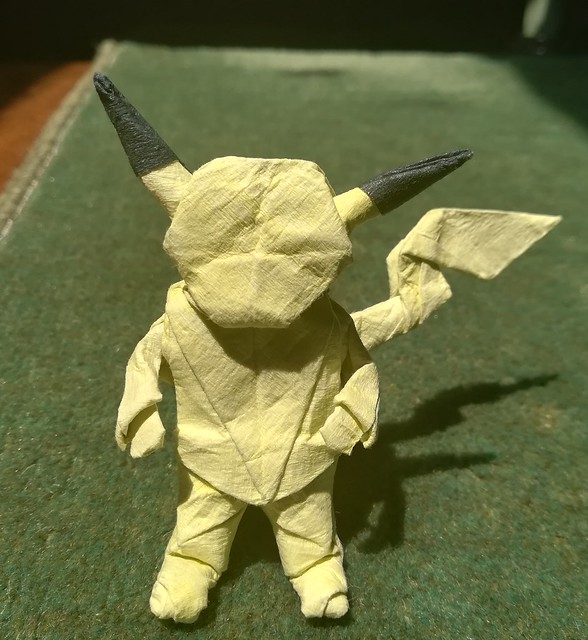 Pikachu by Can Cebeci, on Flickr
Pikachu by Can Cebeci, on Flickr
And here is a photo of its back where the tail can be seen better.
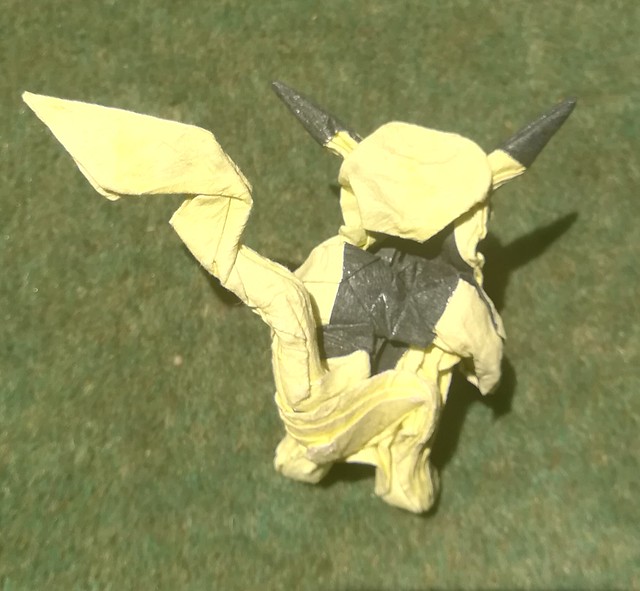 pikachu_back by Can Cebeci, on Flickr
pikachu_back by Can Cebeci, on Flickr
Pikachu by Ivan Danny Handoko
Paper: 25*25 cm tissue foil with yellow on one side and black on the other
Instruction: The CP is on his flickr. Here is the link: https://www.flickr.com/photos/ivandanny/11581228386
 Pikachu by Can Cebeci, on Flickr
Pikachu by Can Cebeci, on FlickrAnd here is a photo of its back where the tail can be seen better.
 pikachu_back by Can Cebeci, on Flickr
pikachu_back by Can Cebeci, on Flickr-
Can Cebeci
- Junior Member
- Posts: 55
- Joined: September 8th, 2014, 9:26 pm
Re: Can Cebeci's Gallery
Hey there people! I have been on a vacation for the past week so it's been quite a number of days without sharing a new model. Anyway, I finally re-started reading Origamni Design Secrets. Here is a model diagrammed there.
(not so) Ruby-throated Hummingbird by Robert Lang
Paper: 20*20 cm tissue foil
Instruction: Diagrams are in Origami Design Secrets.
 Hummingbird by Can Cebeci, on Flickr
Hummingbird by Can Cebeci, on Flickr
(not so) Ruby-throated Hummingbird by Robert Lang
Paper: 20*20 cm tissue foil
Instruction: Diagrams are in Origami Design Secrets.
 Hummingbird by Can Cebeci, on Flickr
Hummingbird by Can Cebeci, on Flickr